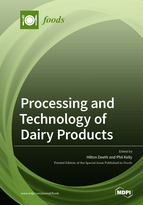Processing and Technology of Dairy Products
A special issue of Foods (ISSN 2304-8158). This special issue belongs to the section "Dairy".
Deadline for manuscript submissions: closed (30 June 2019) | Viewed by 37512
Special Issue Editors
Interests: dairy science and technology; UHT processing and products; whey proteins; thermal and nonthermal processing; new product development
Special Issues, Collections and Topics in MDPI journals
Interests: physico-chemical and functional changes to milk and other milk-derived streams during processing, especially concentration and dehydration; characterization of compositional and biofunctional aspects of milk fat globule membrane (MFGM)-enriched dairy streams; innovative developments in membrane separation technology for targeted enrichment and enhanced functionality of milk-derived ingredients in food formulation
Special Issues, Collections and Topics in MDPI journals
Special Issue Information
Dear Colleagues,
It is remarkable that starting from one raw material, milk, the dairy industry has been able to produce a large range of consumer dairy products, as well as commodity powders and specialised ingredients with a multitude of functional characteristics and applications. The technologies used and the processes involved in these transformations are the foci of this Special Issue. Papers, both original contributions and review papers, will be welcomed on the well-established unit operations such as heat treatments and membrane separation in addition to emerging technologies, such as non-thermal processes, dairy-based encapsulation and 3-D printing. The physical, chemical, microbiological, sensory and nutritional characteristics of the products, and their changes during processing and storage naturally fall within the scope of the issue.
Prof. Dr. Hilton Deeth
Dr. Phil Kelly
Guest Editors
Manuscript Submission Information
Manuscripts should be submitted online at www.mdpi.com by registering and logging in to this website. Once you are registered, click here to go to the submission form. Manuscripts can be submitted until the deadline. All submissions that pass pre-check are peer-reviewed. Accepted papers will be published continuously in the journal (as soon as accepted) and will be listed together on the special issue website. Research articles, review articles as well as short communications are invited. For planned papers, a title and short abstract (about 100 words) can be sent to the Editorial Office for announcement on this website.
Submitted manuscripts should not have been published previously, nor be under consideration for publication elsewhere (except conference proceedings papers). All manuscripts are thoroughly refereed through a single-blind peer-review process. A guide for authors and other relevant information for submission of manuscripts is available on the Instructions for Authors page. Foods is an international peer-reviewed open access semimonthly journal published by MDPI.
Please visit the Instructions for Authors page before submitting a manuscript. The Article Processing Charge (APC) for publication in this open access journal is 2900 CHF (Swiss Francs). Submitted papers should be well formatted and use good English. Authors may use MDPI's English editing service prior to publication or during author revisions.
Keywords
- Milk
- Dairy products
- Dairy technology
- Dairy processing
- Heating
- Separation
- Fractionation
- Concentration
- Drying
- Fermentation
- Storage
- Non-thermal technologies







